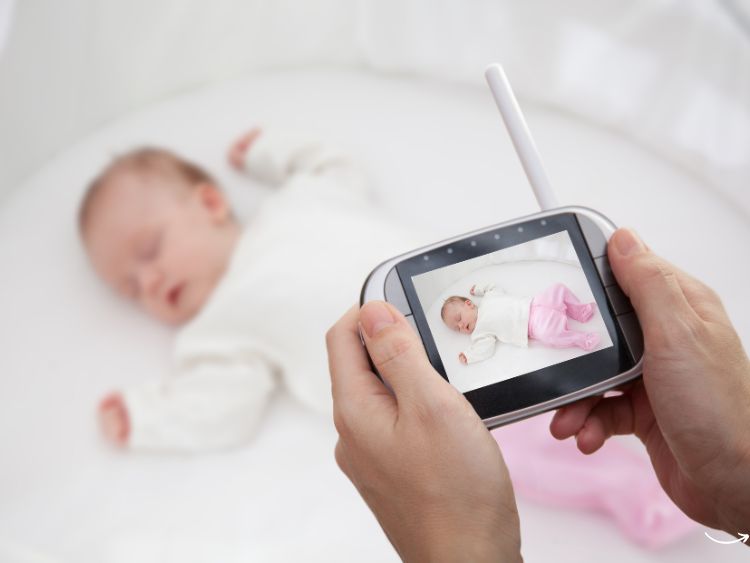Why a Baby Monitor Is a Must-Have
Let’s face it—parenting is no walk in the park. Between feedings, diaper changes, and trying to snag a wink of sleep, keeping an ear out for your baby is crucial. That’s where a baby monitor becomes your best friend. These nifty devices let you keep tabs on your little one without hovering over the crib 24/7.
But wait, with so many options, how do you pick the right one? No worries—we’ve got you covered. In this guide, we’ll break down everything you need to know about baby monitors, from the types available to the must-have features.
Types of Baby Monitors
Before diving into the nitty-gritty, let’s get familiar with the types of baby monitors out there.
1. Audio Baby Monitors
- What it does: Transmits sounds from your baby’s room.
- Best for: Parents who just need to hear their baby without fancy extras.
- Pros: Affordable, long battery life.
- Cons: Lacks visual feedback.
2. Video Baby Monitors
- What it does: Offers live video and audio of your baby.
- Best for: Parents who want to visually check in on their baby.
- Pros: Real-time visuals, night vision capabilities.
- Cons: Can be pricey.
3. Smart Baby Monitors
- What it does: Syncs with your smartphone for advanced features like motion detection and sleep tracking.
- Best for: Tech-savvy parents.
- Pros: Remote monitoring, tons of features.
- Cons: Expensive, requires Wi-Fi.
4. Wearable Baby Monitors
- What it does: Tracks your baby’s vitals like heart rate and oxygen levels.
- Best for: Parents of preemies or those with medical concerns.
- Pros: Peace of mind, health tracking.
- Cons: May not replace traditional monitors.
Features to Consider When Choosing a Baby Monitor
With so many options, it’s easy to feel overwhelmed. Let’s break it down.
1. Range
If you live in a larger home, look for a monitor with a long-range signal. Most monitors cover around 800–1000 feet, but some go further.
2. Battery Life
No one wants their monitor to die in the middle of the night! Choose one with a long-lasting battery or one that supports charging while in use.
3. Camera Quality
For video monitors, pay attention to resolution and night vision. After all, you’ll want a clear view of your baby whether it’s day or night.
4. Two-Way Audio
This feature lets you talk to your baby through the monitor—a lifesaver for soothing them back to sleep without entering the room.
5. Wi-Fi Connectivity
Want to monitor your baby from anywhere? Wi-Fi-enabled monitors let you check in via an app, but ensure you have a secure network to avoid hacking risks.
Top Baby Monitor Picks for 2024
We’ve done the legwork to bring you the best of the best. Here are our top picks:
1. Infant Optics DXR-8 Pro
- Type: Video
- Key Features: Interchangeable lenses, secure signal, long battery life.
- Why We Love It: It’s reliable and offers excellent video quality without needing Wi-Fi.
2. Nanit’s Pro Smart Monitor
- Type: Smart
- Key Features: Sleep tracking, breathing monitoring, real-time insights.
- Why We Love It: Perfect for data-loving parents who want detailed reports.
3. VTech DM221 Audio Monitor
- Type: Audio
- Key Features: Long-range, crystal-clear sound, affordable price.
- Why We Love It: A budget-friendly option with all the essentials.
Baby Monitor Tips and Tricks
Now that you know the types and features, here are some quick tips to make the most of your baby monitor:
- Place the monitor strategically: Position it where it captures the crib clearly but stays out of reach.
- Secure your Wi-Fi network: If you’re using a smart monitor, a strong password is a must.
- Test the range: Walk around your house to ensure the signal doesn’t drop.
- Keep it clean: Regularly wipe the camera and microphone for clear visuals and sound.
FAQs About Baby Monitors
1. What’s the ideal range for a baby monitor?
Most monitors offer a range of 800–1000 feet. However, if you live in a multi-story home, you might need a more robust model.
2. Are Wi-Fi monitors safe to use?
Yes, as long as your network is secure. Always use a strong, unique password to protect against unauthorized access.
3. Do I need a monitor with video?
It depends! If you feel comfortable just hearing your baby, an audio monitor is enough. But if you want to see them, go for a video or smart monitor.
4. How long do baby monitors last?
With proper care, most monitors last 2–3 years, which covers your baby’s infancy and toddler years.
5. Can I use a baby monitor for twins?
Absolutely! Many monitors support multiple cameras, making them ideal for twins or multiple kids.
Summary: Finding Your Perfect Baby Monitor
At the end of the day, the right baby monitor depends on your family’s needs. Whether you prefer a basic audio device or a feature-packed smart monitor, there’s an option for every budget and lifestyle. Remember to prioritize safety, ease of use, and reliability.
Authoritative Links
- https://www.consumerreports.org/baby-monitors
- https://www.whattoexpect.com/baby-products/baby-monitors
- https://www.mayoclinic.org/tests-procedures/pediatric-sleep-studies/expert-answers
